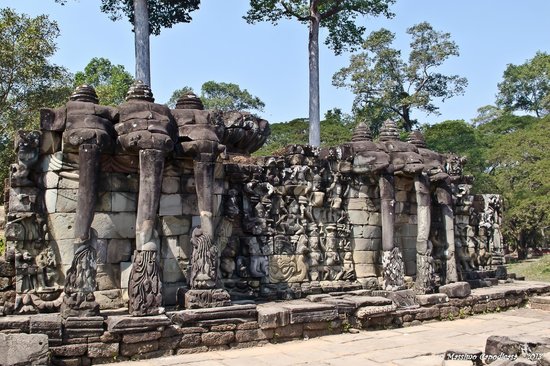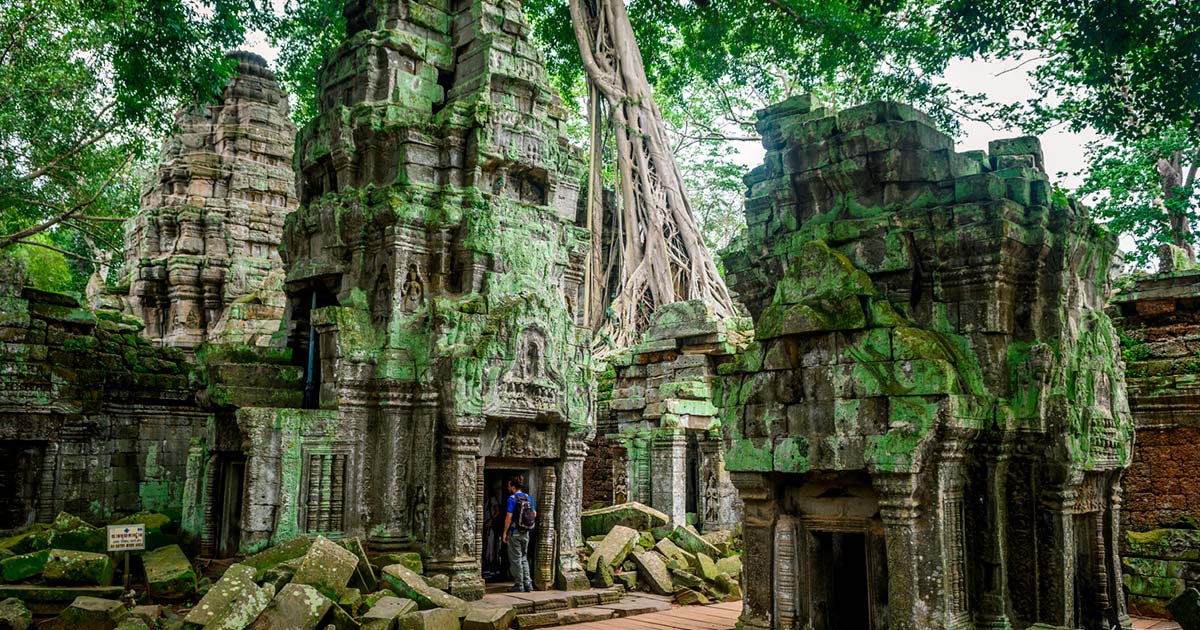In the one-day tour package with Angkor Pioneer Tour, we will take you to visit the famous historical landmarks of Cambodia as listed below. If you wish to visit other tourist sites that are not included in the tour package we have arranged, you can also create your own custom tour package. Simply click on the phrase ‘Customize your trip ,’ then write the names of the tourist sites you would like to visit and send them to us.
Siem Reap



Watching the sunrise at Angkor Wat temple in Cambodia is an experience that transcends mere sightseeing—it’s a journey into the heart of history, spirituality, and natural beauty. For photography enthusiasts, the sunrise at Angkor Wat presents an unparalleled opportunity to capture stunning images of one of the world’s most iconic landmarks. The interplay of light and shadow, the silhouettes of temple spires against the dawn sky, and the reflection of the temple in the nearby ponds create an endless array of compositions waiting to be captured. Whether you’re a professional photographer or simply someone who appreciates the beauty of nature, the sunrise at Angkor Wat offers a visual feast that will leave you spellbound. Ultimately, the sunrise at Angkor Wat is not just about what you see, but how it makes you feel. It’s about the sense of wonder that fills your soul as you witness the unfolding drama of dawn in this mystical setting.



Angkor Wat is one of the most iconic and impressive temple complexes in the world. Built in the early 12th century by King Suryavarman II, Angkor Wat is a masterpiece of Khmer architecture and a symbol of the grandeur and power of the Khmer Empire. King Suryavarman II, a powerful ruler who reigned from 1113 to 1150, commissioned the construction of Angkor Wat as a state temple and mausoleum dedicated to the Hindu god Vishnu. The temple was designed to serve as a spiritual and political center, reflecting the king’s devotion to Vishnu and his desire to establish a lasting legacy. Angkor Wat is renowned for its monumental scale, intricate carvings, and sophisticated architectural design. The temple complex covers an area of over 162 hectares and consists of multiple galleries, courtyards, towers, and basins arranged in a symmetrical layout that reflects the Hindu cosmology. After the decline of the Khmer Empire in the 15th century, Angkor Wat was gradually abandoned and fell into disrepair until it was rediscovered by French explorers in the 19th century. Since then, the temple has been extensively restored and preserved, becoming a UNESCO World Heritage Site and a symbol of Cambodia’s cultural heritage.




The Bayon Temple is a striking and enigmatic temple complex located at the heart of the ancient city of Angkor Thom in Cambodia. Built in the late 12th or early 13th century by King Jayavarman VII, the Bayon Temple is renowned for its impressive architecture, intricate bas-reliefs, and iconic stone faces. King Jayavarman VII, one of the most powerful and ambitious rulers of the Khmer Empire, commissioned the construction of the Bayon Temple as the state temple of his capital city, Angkor Thom. The temple was dedicated to Mahayana Buddhism, reflecting the king’s religious beliefs and his desire to create a monumental symbol of his reign.The bas-reliefs of the Bayon Temple depict a wide range of subjects, including historical events, mythological scenes, and everyday life in ancient Khmer society. Over the centuries, the Bayon Temple fell into disrepair and was partially reclaimed by the jungle until it was rediscovered and restored in the 20th century. Today, it stands as a UNESCO World Heritage Site and a testament to the artistic and architectural achievements of the Khmer civilization.



The Bayon Temple is a striking and enigmatic temple complex located at the heart of the ancient city of Angkor Thom in Cambodia. Built in the late 12th or early 13th century by King Jayavarman VII, the Bayon Temple is renowned for its impressive architecture, intricate bas-reliefs, and iconic stone faces. King Jayavarman VII, one of the most powerful and ambitious rulers of the Khmer Empire, commissioned the construction of the Bayon Temple as the state temple of his capital city, Angkor Thom. The temple was dedicated to Mahayana Buddhism, reflecting the king’s religious beliefs and his desire to create a monumental symbol of his reign.The bas-reliefs of the Bayon Temple depict a wide range of subjects, including historical events, mythological scenes, and everyday life in ancient Khmer society. Over the centuries, the Bayon Temple fell into disrepair and was partially reclaimed by the jungle until it was rediscovered and restored in the 20th century. Today, it stands as a UNESCO World Heritage Site and a testament to the artistic and architectural achievements of the Khmer civilization.



Phimeanakas Temple, located within the Angkor Archaeological Park in Siem Reap, Cambodia, is a fascinating ancient monument that offers visitors a glimpse into the rich history and architectural brilliance of the Khmer Empire. Phimeanakas, meaning “Celestial Palace,” is an intricately designed temple steeped in history. Constructed during the reign of King Rajendravarman II in the late 10th century and later expanded by King Jayavarman VII in the 12th century, the temple served as a royal palace and the focal point of Khmer court life. The temple’s architectural style reflects the transition between the early Khmer temple design and the more elaborate structures that followed. Built in the pyramid shape typical of Khmer temples, Phimeanakas features a series of ascending terraces leading to a central sanctuary tower. The intricate carvings adorning the sandstone walls depict Hindu mythological scenes and divine beings, showcasing the exquisite craftsmanship of the Khmer artisans. According to local tradition, the temple was once inhabited by the Naga, a mythical serpent-like creature, who transformed into a beautiful woman every night. The Khmer king was required to visit the temple each night to fulfill his duty of spending the night with the Naga queen, ensuring the prosperity and fertility of the kingdom. This myth adds a layer of intrigue to the temple’s history, inviting visitors to imagine the mystical world of ancient Cambodia.



The Terrace of the Elephants is one of the most iconic and remarkable structures in the Angkor Archaeological Park, located in Siem Reap, Cambodia. It is a royal platform that was part of the larger complex of Angkor Thom, the last capital of the Khmer Empire. The Terrace of the Elephants was built in the late 12th century during the reign of King Jayavarman VII (1181–1218 AD). Jayavarman VII was one of the most powerful and influential kings of the Khmer Empire and is also credited with expanding the empire’s territory and building many of its most famous monuments. The terrace was likely used for royal ceremonies, public appearances, and rituals, as well as a platform for the king and his court to observe parades, military victories, and other state events. It may also have served a ceremonial function, as evidenced by its symbolic depictions of elephants, which were revered in Khmer culture.



Ta Prohm is a captivating temple complex located in the Angkor Archaeological Park in Cambodia. Built in the late 12th and early 13th centuries by King Jayavarman VII, Ta Prohm is a unique and atmospheric temple that has been left in a partially ruined state, with the jungle reclaiming much of its structure. King Jayavarman VII, a powerful ruler known for his ambitious building projects and patronage of Buddhism, commissioned the construction of Ta Prohm as a Mahayana Buddhist monastery and university. The temple was dedicated to the king’s mother and symbolized the union of religion and royalty in Khmer society. Ta Prohm is renowned for its distinctive architectural style, which features a combination of traditional Khmer design elements and innovative features such as flat roofs, square galleries, and cruciform sanctuaries. The temple complex covers an area of over 40 hectares and consists of multiple enclosures, courtyards, towers, and galleries adorned with intricate carvings and bas-reliefs. One of the most striking features of Ta Prohm is the way in which the temple has been enveloped by the roots of giant silk-cotton trees, creating a dramatic and otherworldly atmosphere.
What to bring
Not allowed
Know before you go
Feel free to adjust any details or add specific information relevant to your destination or travel agency. Let me know if you need further customization!
Copyright © 2024 Angkor Pioneer Tour.
Our team of passionate guides are here would love to hear from you.
